Shenjie Huang
Single-Photon Counting Receivers for 6G Optical Wireless Communications
May 16, 2023



Abstract:Optical wireless communication (OWC) offers several complementary advantages to radio-frequency (RF) wireless networks such as its massive available spectrum; hence, it is widely anticipated that OWC will assume a pivotal role in the forthcoming sixth generation (6G) wireless communication networks. Although significant progress has been achieved in OWC over the past decades, the outage induced by occasionally low received optical power continues to pose a key limiting factor for its deployment. In this work, we discuss the potential role of single-photon counting (SPC) receivers as a promising solution to overcome this limitation. We provide an overview of the state-of-the-art of OWC systems utilizing SPC receivers and identify several critical areas of open problems that warrant further research in the future.
SPAD-Based Optical Wireless Communication with ACO-OFDM
Oct 25, 2022



Abstract:The sensitivity of the optical wireless communication (OWC) can be effectively improved by employing the highly sensitive single-photon avalanche diode (SPAD) arrays. However, the nonlinear distortion introduced by the dead time strongly limits the throughput of the SPAD-based OWC systems. Optical orthogonal frequency division multiplexing (OFDM) can be employed in the systems with SPAD arrays to improve the spectral efficiency. In this work, a theoretical performance analysis of SPAD-based OWC system with asymmetrically-clipped optical OFDM (ACO-OFDM) is presented. The impact of the SPAD nonlinearity on the system performance is investigated. In addition, the comparison of the considered scheme with direct-current-biased optical OFDM (DCO-OFDM) is presented showing the distinct reliable operation regimes of the two schemes. In the low power regimes, ACO-OFDM outperforms DCO-OFDM; whereas, the latter is more preferable in the high power regimes.
Spatial and Wavelength Division Joint Multiplexing System Design for Visible Light Communications
Sep 20, 2022
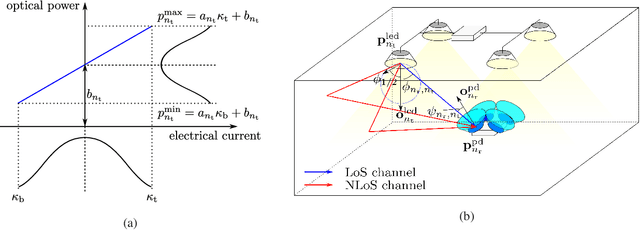
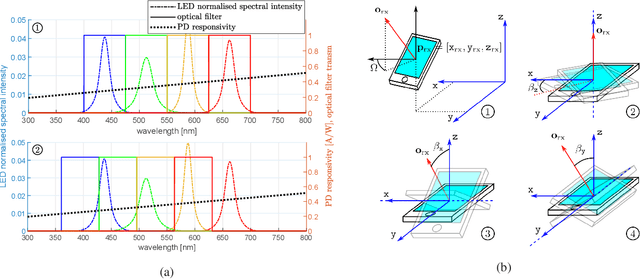

Abstract:The low-pass characteristics of front-end elements including light-emitting diodes (LEDs) and photodiodes (PDs) limit the transmission data rate of visible light communication (VLC) and Light Fidelity (LiFi) systems. Using multiplexing transmission techniques, such as spatial multiplexing (SMX) and wavelength division multiplexing (WDM), is a solution to overcome bandwidth limitation. However, spatial correlation in optical wireless channels and optical filter bandpass shifts typically limit the achievable multiplexing gain in SMX and WDM systems, respectively. In this paper, we consider a multiple-input multiple output (MIMO) joint multiplexing VLC system that exploits available degrees-offreedom (DoFs) across space, wavelength and frequency dimensions simultaneously. Instead of providing a new precoder/post-detector design, we investigate the considered joint multiplexing system from a system configuration perspective by tuning system parameters in both spatial and wavelength domains, such as LED positions and optical filter passband. We propose a novel spatial clustering with wavelength division (SCWD) strategy which enhances the MIMO channel condition. We propose to use a state-of-the-art black-box optimization tool: Bayesian adaptive direct search (BADS) to determine the desired system parameters, which can significantly improve the achievable rate. The extensive numerical results demonstrate the superiority of the proposed method over conventional SMX and WDM VLC systems.
Performance Analysis of SPAD-Based Optical Wireless Communication with OFDM
Jun 04, 2022



Abstract:In recent years, there has been a growing interest in the use of single-photon avalanche diode (SPAD) in optical wireless communication (OWC). SPAD operates in the Geiger mode and can act as a photon counting receiver obviating the need for a transimpedance amplifier (TIA). Although a SPAD receiver can provide higher sensitivity compared to the traditional linear photodetectors, it suffers from the dead-time-induced nonlinearity. To improve the data rates of SPAD-based OWC systems, optical orthogonal frequency division multiplexing (OFDM) can be employed. This paper provides a comprehensive theoretical analysis of the SPAD-based OWC systems using OFDM signalling considering the effects of signal clipping, SPAD nonlinearity, and signal-dependent shot noise. An equivalent additive Gaussian noise channel model is proposed to describe the performance of the SPAD-based OFDM system. The statistics of the proposed channel model and the analytical expressions of the signal-to-noise ratio (SNR) and bit error rate (BER) are derived in closed forms. By means of extensive numerical results, the impact of the unique receiver nonlinearity on the system performance is investigated. The results demonstrate new insights into different optical power regimes of reliable operation for SPAD-based OFDM systems even well beyond SPAD saturation level.
5 Gbps Optical Wireless Communication using Commercial SPAD Array Receivers
Nov 13, 2021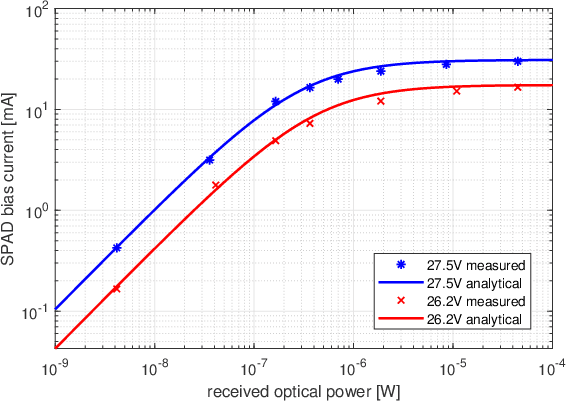
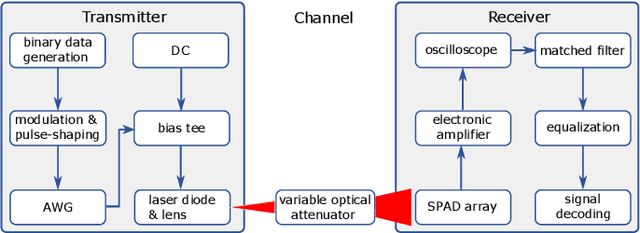
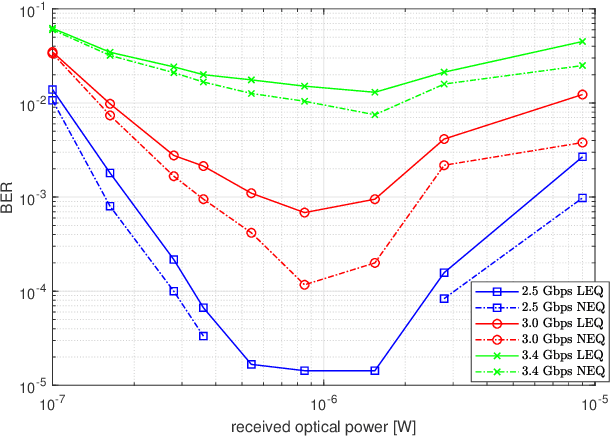
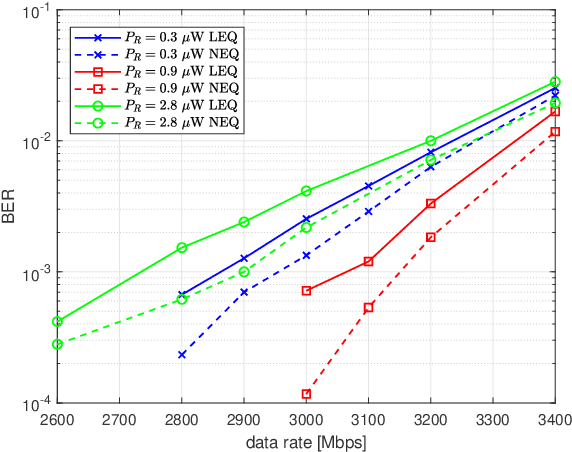
Abstract:Photon counting detectors such as single-photon avalanche diode (SPAD) arrays can be utilized to improve the sensitivity of optical wireless communication (OWC) systems. However, the achievable data rate of SPAD-based OWC systems is strongly limited by the nonlinearity induced by SPAD dead time. In this work, the performances of SPAD receivers for two different modulation schemes, namely, on-off keying (OOK) and orthogonal frequency division multiplexing (OFDM), are compared demonstrating contrasting optimal regimes of operation. We employ nonlinear equalization and peak-to-average power ratio optimization by adjusting the OFDM clipping level to achieve record experimental data rates of up to 5 Gbps. In particular, the experimental results demonstrate the achievable data rates of 3.22 Gbps and 5 Gbps when OOK and OFDM are employed, respectively. It is also illustrated that to achieve the best data rate performance over a wide range of received power, adaptive switching between OOK and OFDM may be utilized.
 Add to Chrome
Add to Chrome Add to Firefox
Add to Firefox Add to Edge
Add to Edge